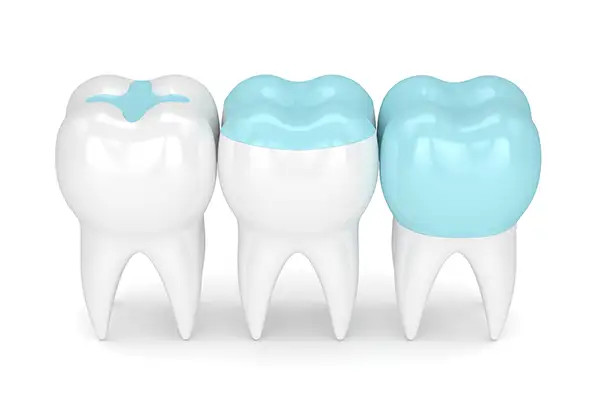Inlays and Onlays Avery Dental Center offers inlays and onlays to restore the appearance, function, and health of your teeth. Find out more about these restorative dentistry treatments. Inlays and onlay are tooth restorations that tend to be used when decay is too large for fillings but generally too small for crowns. They require less preparation of the teeth than a full-blown crown restoration. Avery Dental Center offers inlays and onlays to restore the appearance, function, and health of your teeth. Find out more about these restorative dentistry treatments. Inlays and onlay are tooth restorations that tend to be used when decay is too large for fillings but generally too small for crowns. They require less preparation of the teeth than a full-blown crown restoration. What Is the Difference Between an Inlay and an Onlay?Inlays are used to repair the chewing surface of a back tooth and mend larger cavities when conventional fillings would not be strong enough. These deep fissures can easily trap plaque, food, or bacteria which causes decay that often develops into cavities on these surfaces. An onlay is similar to an inlay but is larger. It is suitable for repairing cusps (the pointed protrusions on the top of the back teeth). What is the Process for Getting an Inlay or Onlay?Inlays and onlays are similar to crowns in that they are prepared by technicians rather than your dentist. At your initial appointment for an inlay or onlay, you will have any decay addressed before a temporary filling is placed until it can be sent off to make molds which will create custom-fitted pieces made just for you. When you return to have your inlay or onlay affixed, the dentist will remove the temporary filling and place the inlay or onlay. It is secured permanently to the tooth using a light-activated adhesive that forms a strong bond. After your appointment, you need to avoid hard foods for 48 hours until the bond is secured. In addition, ensure that you avoid beverages of extreme hot/cold temperatures. What Materials are Inlays and Onlays Made From?There are several options for the materials used in inlays and onlays. You may choose based on durability, strength, or esthetic qualities balancing longevity, cost, and the cosmetic result. Many people opt for a material that can be color-matched to their teeth to give a natural-looking result. Thus, choosing ceramic porcelain or composite resin is a good option in these cases. Gold metal is also an option that can give your mouth some bling while providing durable protection against damage like cracks or chips—although the look is not necessarily to everyone's taste. There is no one perfect material because preferences vary from person to person. However, we will discuss the pros and cons with you, so you are able to make your own informed choice. How Long Do Inlays Onlays Last?Inlays and onlays can restore your teeth to their full structure, function, and appearance so you can eat, bite, and chew food without impediment. With good care, they can last for up to 15 years. Regardless of whether you have restorative dental treatments or not, it is of enormous benefit to your long-term oral health to maintain a clean, healthy mouth to prevent diseases that affect your teeth and gums. A twice-daily brushing and flossing routine with regular visits to the dentist will ensure you will keep your mouth as hygienic as possible and help to keep disease at bay. Schedule an appointment at Avery Dental Center by phoning (380) 257-1684 to find out more. |